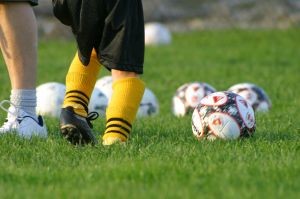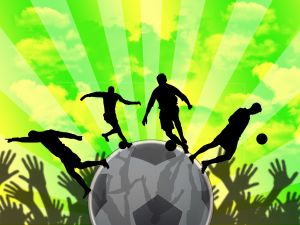By Bailee Holt-Sandsmark, CSCS
In part 1 of this series, I discussed the physical, mental, and emotional benefits for special needs kids when they are mainstreamed into physical education classes. In this article, I will discuss the various methods of adapting curriculum so that all students are at an advantage, regardless of their disability.
I have found that modifying activities not only creates an environment that is less intimidating, it also allows all students the opportunity to learn and thrive. In middle school, all students are required to participate in physical education, regardless of their extracurricular activities, and in high school, the majority of the students who participate in physical education are the students who are not athletes. This means that this is the population of students who NEED to be moving and developing life long fitness habits. The best way to do that is to develop lessons that allow the students to realize successes rather than failures.
There are four major ways to adapt activities for all students:
- Modification of activities
- Modification of the games
- Modification of communication
- Modification of teaching materials
Modification of activities
First, modification of the activities includes modifying the rules to allow for more opportunities for success. For example, when playing baseball, softball, or whiffleball, players left on base at the end of the inning can return to that base the next time they are on offense. This allows more scoring opportunity for the kids and a greater sense of accomplishment when they do score. What kid doesn’t like scoring a point for their team?
 Adjusting the equipment is another great way to alter the activity. This can be done by making the ball bigger or smaller and using larger targets or goals. These modifications allow greater opportunities for students who struggle with hand-eye or foot-eye coordination.
Adjusting the equipment is another great way to alter the activity. This can be done by making the ball bigger or smaller and using larger targets or goals. These modifications allow greater opportunities for students who struggle with hand-eye or foot-eye coordination.
Modifying the playing area can be helpful by making the boundaries smaller and marking the positions on the playing area to help students remember where they should be on the field.
Finally, modifying the actions of the skill required may also increase the probability of success for all students. In volleyball, allowing students to use a fist to clasp their hands for the bump pass and allowing students to palm the ball instead of using finger tips for the set, reduces the level of difficulty of the skills required.
Modification of the games
Modifying the skills and rules for the sports is another method to equalize the playing field for all students. For example, in basketball, using a lighter ball, allowing traveling and double dribbling, and lowering the hoop, are all simple ways to modify basketball.
Another example of a modification of a sport is allowing a bounce in volleyball. At my school, we call this volley-tennis. Allowing a bounce in between touches slows the pace of the game and allows students to improve their timing and control of the ball.
Modification of communication
Communication can be a huge barrier for students with special needs, as well as English Learners. It is important to use multiple methods of communication to ensure that all students receive information through a communication method that they understand. It is also important to remember that all lessons should include visual, auditory, and kinesthetic learning and instruction.
Displaying the playing field or court on a white board, and using it to demonstrate the method of play, can be a great visual aid. I recommend using the same colors on the white board as the lines in the gym, to help students associate the visual diagram to the actual gym floor. This will help them recognize the boundaries when they begin game play.
Also, doing a “demo” game is a great tool to allow students who understand the game to teach the rest of the class. This also allows the students not in the demo game to see the game playing first hand. I recommend narrating, similar to a sports commentator, during the demo game, calling out the play-by-play, and explaining the offense, defense, and penalties as it unfolds. Remember to face the students who are not in the demo game and be sure to stop the game as necessary to emphasize important rules or scenarios.
Speech is another important tool, especially for auditory learners. Using a strong, expressive voice, and speaking slowly and clearly ensures that the instruction is easier to understand and process. Also, when asking questions, it is helpful to ask short questions that require short answers. This allows students to process the question and formulate answers quickly, as well as keep them engaged.
Cognitive communication may be the most important factor. This includes allowing students enough time to practice the new skills. Repetition, repetition, repetition! This means repeating important rules or concepts each day before students begin playing, to remind them of the rules or strategies that are important to the game. Most special needs students struggle with change, so it is important to establish rules, ensure that they are simple and enforced, and give the students many opportunities to practice and play.
Modification of teaching materials
The final important thing to remember is to use multiple teaching tools. This includes visual aids, such as the white board mentioned before or by showing the skill to be performed through a video clip on YouTube. We like to show examples of Olympic athletes.
If any signs or printed tools are being used, be sure that the font is large and in an easy to read font, and colored paper can be eye-catching. Providing students with handouts they can refer to during the lesson that may contain the rules, important vocabulary, etc., can also be beneficial.
The goal in creating lessons that allow ALL students to thrive is to simplify the game to allow for greater opportunities for success. We want to develop young adults who find a sport or activity they enjoy, that they can be successful at, and that they can know and enjoy enough to participate in after school or on the weekends for years to come.
Craig Valency, MA, CSCS, president and co-founder of SPIDERfit, has been a personal trainer for the last 11 years. He is currently working at Fitness Quest 10 in San Diego, an elite personal training and athletic conditioning facility. He specializes in youth strength and conditioning programs that promote physical literacy, injury prevention and optimal performance. Along with training youths from 6 to 18 years of age for general fitness, Craig has also worked with some of the top junior tennis players in the world. He has been a physical education consultant for the Stevens Point school district in Wisconsin for the last 3 years, helping revamp the district wide programming for the K-12 PE curriculum. Craig earned his bachelor degree from UCLA, and Masters Degree in Kinesiology from San Diego State University.





Connect with SPIDERfit!